

The Best of Everything
Encyclopedia Entry • Films Main
The Story of Esther Costello
1957


Critics' Reviews • Our Reviews • Movie Posters • Lobby Cards • Misc. • Books
Click here to see photos from the film.
|
US general release: 11/6/57.
VHS release: 2/11/97. DVD release (as part of TCM's "Joan Crawford in the 1950s" 4-disc set): 11/25/14. Cast: Joan Crawford (as "Margaret Landi"), Rossano Brazzi, Heather Sears, Lee Patterson, Ron Randell, Fay Compton, John Loder, Denis O'Dea, Sidney James, Bessie Love, Robert Ayres, Maureen Delaney, Harry Hutchinson, Tony Quinn. Credits: From the novel by Nicholas Monsarrat. Screenplay: Charles Kaufman. Producer/Director: David Miller. Camera: Robert Krasker. Art Direction: George Provis, Tony Masters. Music: Lambert Williamson. Gowns: Jean Louis. Editor: Ralph Kemplen.
Awards: 1958: British Film Academy: Award for Best British Actress, Heather Sears. Nominated for Best Screenplay, Charles Kaufman. Golden Globes: Nominated for Best Supporting Actress, Heather Sears. 1957 Venice Film Festival: Director David Miller nominated for a Golden Lion.
Plot Summary: The Story of Esther Costello is the cinematic equivalent of eating a whole box of potato chips; you may hate yourself, but you'll relish every bite in the meantime. Joan Crawford plays a well-meaning woman who throws herself whole-hog into every charitable cause that comes down the pike. She is married to Rossano Brazzi, who is as greedy as Crawford is generous. Crawford rescues blind deaf-mute Heather Sears from her squalid surroundings, leading to her creation of a charity campaign on behalf of handicapped children, with Sears as "poster child." Brazzi, in league with crooked promoter Ron Randell, seizes upon this as a means to line his own pocket--and one night, he decides to assert his manhood with the helpless Sears. The shock of this assault causes the girl to instantly regain her sight and hearing! Crawford reacts to her husband's outrage by driving her car into a tree, snuffing out Brazzi's life as well as her own. Sears--or Esther Costello, for she is indeed the title character--finds happiness with an honest young reporter (Lee Patterson). Set in America and released by an American company (Columbia), The Story of Esther Costello was nonetheless filmed in its entirety in England. ~ Hal Erickson, All Movie Guide
|
Bosley Crowther in the New York Times November 6, 1957 It's unfortunate that a smoothly-machined, well-acted drama like "The Story of Esther Costello" should have serious shortcomings. Such is the case with the British-made Columbia entry that arrived yesterday at the Palace, featuring Joan Crawford, Rossano Brazzi and a strikingly gifted girl named Heather Sears in the title role. And very interestingly the shortcomings are those of Nicholas Monsarrat's novel. The singularly repellent plot—the blatant, heartless exploitation of a blind deafmute—lacks complete credibility. It leaves a bitter, even sour taste that's impossible to whistle away. The same applies to the virtues of a harsh drama of rampant evil that remains original, curiously engrossing, and deftly shaped for unquestioning adults. As the film opens, a rich American tourist, Miss Crawford, compassionately salvages an afflicted Irish waif, Miss Sears, and doggedly assists in the girl's mastery of Braille at an American institution. These rehabilitation scenes are excellent, as crisply directed by David Miller and blue-printed in semi-documentary low key by Scenarist Charles Kaufman. And it must be said here that Miss Crawford, whose role repeatedly shifts from stage center, is tackling her most becoming assignment in several seasons. But the bulk of the action, and certainly the villainy, lies in the shrewd, heartless exploitation of the "miracle" girl on an international promotion tour engineered by Miss Crawford's estranged spouse, Mr. Brazzi. At the tour's fantastically successful peak, this handsome conniver abruptly ravishes his new protégée, thereby restoring her speech and sight. Miss Crawford arranges the deaths of herself and Mr. Brazzi (admirably suggested rather than shown) and the victimized girl marches off to enlighten a packed auditorium, trailed by a loving young reporter, Lee Patterson. To one viewer, at least, the picture's real miracle is that such a plot even approaches credulity, yet it does just that. Miss Crawford, Mr. Brazzi, Mr. Patterson and all the minor players are professional throughout, and for once, the injection of a puppy romance is welcome. But it is the glowing, winsome, mobile face of young Miss Sears that makes the whole thing matter at all. What, pray, is so miraculous today about a deaf-mute's mastery of Braille? Would mere podium appearances rake in large contributions from our country, France and Italy? And what about the terrible act that completely cures the young heroine? It's all cause for wonder in an off-beat picture that is smooth and anything but sweet.
William K. Zinsser in the New York Herald Tribune (1957) It wouldn't be a Joan Crawford picture without plenty of anguish--so goes a rigid law of the film industry. And her fans will have their usual good time...smiling through their tears, biting their nails, and otherwise purging the emotions....As you can imagine, this plot enables Miss Crawford to run a full-course dinner of dramatic moods, from loneliness to mother love, from pride in the girl to passion with her husband, and finally to smouldering rage when she takes a derringer out of her desk and goes to meet him for the last time. Somehow she pulls it off. This may not be your kind of movie but it is many women's kind of movie and our Joan is queen of the art form. |
If you've seen The Story of Esther Costello and would like to share your review here, please e-mail me. Include a picture or avatar of yourself to accompany your review, as well as a star-rating (with 5 stars the best) and any of your favorite lines from the film.
Rating:
For the past decade at least, probably more, I'd had it in my head that I very much disliked Esther Costello and thought it was one of the runts of Joan's litter. (A "runt" being defined by me as 2 stars or less.) Upon watching fresh after a very long time, I was pleasantly surprised to find some very good acting by Joan in a couple of scenes, as well as a more-interesting-than-I'd-remembered sub-plot about the dangers of The Media/Publicity Machine.
Joan is "Margaret Landi," a wealthy American on a tour of her ancestral village in Ireland, who's guilted by a local priest into trying to salvage the life of the village blind/deaf teenaged girl---Esther Costello (played by Heather Sears)---currently living in squalor (fighting with a dog for food scraps, etc.). As we viewers see in a scene before the credits: The young Esther and her buddies had been playing in the cellar of a house bombed out in WWII and started fighting over a box of grenades. A grenade goes off, killing Esther's mother and blinding/deafening Esther.
The first half of the film is still pretty cheesy, as I'd remembered: The rich visiting Margaret is beloved by local urchins and nobly throws chocolates at them, while drawing admiring comments like "What a woman!" from decrepit old Irishmen standing around. After guilting by the priest, Margaret then takes Esther to a series of institutes across both Europe and the US, where Esther's infirmities are diagnosed as being primarily psychological in nature. (A creepy hint of her "cure" to come.) When Margaret doesn't find any school instruction sufficient, she endeavors to "train" Esther herself. I remember being extremely annoyed in my earlier viewing at the "clap hands, clap hands, clap hands" scene; it's still annoying. I was also rolling my eyes at how smoothly all of Margaret's efforts went----Esther learns her alphabet, Braille, sign language, typing, geography, how to smile, et al, with only one minor tantrum!
At this point, a young American reporter does a story on the beneficent Margaret's "miracle" transformation of the lowly kid. The media attention leads to speeches from Margaret before local Catholic schools and women's clubs, and a subsequent influx of donations... including a check from Margaret's estranged husband (the beautiful Rossano Brazzi as "Carlo"). The 5-year-absent, smooth-talking, lascivious Carlo insinuates himself back into Margaret's life and bed...while almost immediately starting to eye both the finances AND Esther.
With Carlo back in the picture, the charity appearances explode into an international publicity frenzy of "Give!" "Geef!" "Geben Sie!" Spain even holds bullfights on Esther's behalf! There are American newspaper headlines and TV broadcasts (with pep-rally atmospheres including corny blind singers and local girls with "Esther Costello Club" embroidered on their shirts). And "Esther Costello, Inc." is now a new company on the stock exchange. All of this OTT media frenzy was funnily interesting to me, a la "A Face in the Crowd" (which came out the very same year).
Being a Joan Crawford Film, though, the primary attention turns to Margaret's reactions to Carlo's misbehaviors. Carlo has been smarmily over-interested in Esther from the beginning, constantly touching and petting her, dancing too close to her, hiding sincere letters to her from her innocent reporter beau. Joan's best scene in the film comes when she arrives home and sees Carlo ogling Esther from the balcony as the girl undresses for bed. Margaret rushes into Esther's room, roughly covers her up and yanks shut the drapes leading to the balcony. She then goes out to Carlo in the living room and is initially relatively calm as she presents him with a gift of cuff-links that she'd bought that day, then starts to babble vapidly about the letter that the reporter had sent Esther earlier, then about wanting to change her life, THEIR lives, then about sending Esther away...As she serves Carlo a drink, she finally breaks: "WHY should I lie?!" she cries as she smashes the drink out of his hand...She hates the whole "filthy swindle"---but actually hates it more because of Carlo's attentions to Esther than she does for either Esther or moral reasons... An underrated Joan scene (probably because this film was once not readily available), but one of her best.
The second great set of Joan scenes in the film come near the end, after Margaret comes home early and finds first Carlo's liquor glass in the apartment, then his cuff-link in Esther's bed. And what a surprise to find that Esther can now see and hear! (Wow! All it took was a good rape to get over that whole "psychological" thing! Ahem.) Margaret later goes to meet Carlo at the airport. She's cool and deadpan as she greets him, tells him to have a drink with her, then "Let's go, shall we?" as she hands him the keys to the car...
The above moments are much more interesting than when Margaret comes home and finds that Esther has been raped, then gives her a big hug and says "You're the only one in the world who matters to me..." And then gives her a sleeping pill...! Guess what?! In the original book by Monsarrat, Esther intentionally overdoses on sleeping pills after being raped----and the publicity folks and Margaret cover it up! From Wikipedia: "The novel closes with Margaret, robed in black, giving an impassioned speech at a convention, as millions of attendees open their wallets."
Now THAT would have been a profound, and a much-talked-about, ending in cinema history! As is, Esther Costello falls much short of that. The beginning is sappy, the ending is sappy. But there's some interesting stuff in between.
In 1958 for this film, Heather Sears won the BFA award for Best British Actress. And Charles Kaufman was nominated for the BFA Best Screenplay. In the US, Sears was nominated for a Golden Globe for Best Supporting Actress. And at the 1957 Venice Film Festival, director David Miller was nominated for the Golden Lion award. I honestly don't see any of this being warranted. Sears is a bright-eyed, alert actress, and there are a few honest edges to the film, but not enough to give Esther any sort of actual award credibility.
A melancholic salute, also, to Joan's very last film as a romantic lead.
Rating: Warning: Review contains spoilers! This English film offer gave Miss Crawford one last chance before her later plaintive question: "Why did I get stuck in freak shows?" Thank god for screenwriter Charles Kaufman; the Romulus Brothers; director David Miller (also the director of 1952's Sudden Fear); and producer Jack Clayton (Room at the Top and Beat the Devil), who helps give The Story of Esther Costello the feeling of just, well… being very English. The film was originally called The Golden Virgin, based on a novel of that name by English Navy man Nicholas Monsarrat (who also wrote 1951's The Cruel Sea). This really was Miss Crawford’s goodbye to Hollywood and her career as a woman of a certain age, or a star of a certain age… time goes on. She never jumped ship; she just drank in the Pepsi-cola and moved forward. She did, however, go out with a fantastic celebration while filming in England---feted by the press, competing with the Queen for headlines, giving her first interview on TV. She was introduced to the Queen, given awards by Michael Redgrave and English film critics, embraced by the press that kept counting how many pieces of luggage she brought with her and new husband Alfred Steele (Mr. Pepsi-Cola). She had a smashing party given in her name that was attended by celebrities and/or friends such as Noel Coward, Vivien Leigh, Lawrence Oliver, and Marlene Dietrich (most filming in England at the time). Joan Collins came with a date and wrote later how matronly Crawford looked, but if you look at the pictures of her stay in England and the film, Miss Crawford looks great---she just could not compete with big breasts! (An aside: I was Miss Collins' bellboy in 1983, and she was cold and crisp; her face was buffed and waxed like Joan said hers once looked from trying too hard to defy age and the camera...a piece of Ice she was.) No matter what Crawford fans or critics think
of Esther Costello, the film was indeed Miss Crawford’s own goodbye party
to Hollywood (except Bob
Hope wasn’t there to sing “Thanks for the Memory"): Farewell to women’s pictures---you hit a few homeruns, but now you’re out. The film and Crawford’s performance deserve
more credit because you will cry if you just go with it, but from now on Pepsi, age---and some vodka, along with old Hollywood that couldn’t move forward---got all
confused in the life of Miss Crawford’s Hollywood. The film was released in 1957,
a year in which the decay was now
falling all about Miss Crawford's shoulders…Humphrey Bogart, Louis B. Mayer, Harry Cohn all died in 1957. Her motherdied
in 1958, her husband in 1959. Margaret Sullavan and Gary Cooper and The King,
former lover and co-star Clark
Gable, in 1960.
All I can say is "thank god for the English." If only it could have continued, for Miss Crawford fit well into the English milieu and they used her well. It was a dream of mine to see her with Dirk Bogarde, Gladys Cooper, John Mills, John Williams, Redgrave, and all those wonderful 50’s and 60’s English actors still making films. To mix things up a bit in the land of tea and crumpets, she got an Italian as her co-star for this: Mr. Rossano Brazzi, a hunk that even Katharine Hepburn would turn for. Brazzi's art hustler "Carlo" is sexy and sleazy---a bit of hot-blooded slime that you can’t resist, especially because of his accent and because he is good at ordering wine at dinner! His character's lust for money goes deep. This film is
dramatic and different; it just
did not get enough exposure over the years or got misunderstood or cast aside.
Miss Crawford is slim and elegant (thank you Jean Louis), and vivid, cool, and calm. I have friends who dislike,
or even hate, this movie, but I find it unique in the
realm of the Crawford library of great characters. At the time, women loved this hankie film,
although the virulently anti-Crawford national film critic Bosley
Crowther did not.
Novel author Monsarrat did not even think of The Miracle Worker; the story, despite featuring a deaf-and-blind girl, actually has nothing to do with Helen Keller. Well, in a way it does, for Miss Crawford and her co-star Heather Sears must have studied hard---I mean, you don’t just walk on the set the first day of shooting and start making hand movements and gesturing. It's hard to be bllind, deaf, and dumb, as Esther was, and acting-wise, it's hard to react to. (My favorite line is “What a pity you don’t read Braille”.) The opening of the film makes you realize this is no Female on the Beach. It is realistic and opens with an explosion and people dying (Esther’s mother and, I’m assuming, the two boys she was playing hand grenades with). From the beginning, the script has the audience's sympathy. Miss Crawford’s first appearance as the rich American (a widow with cash and a Cadillac and chocolate bars for the kids) who journeys to her ancestral village in Ireland is walking out of a church with a priest, who encourages her to take Esther from her poverty-stricken, depressing, dirty, useless life with no future. Against her better judgment, Margaret does. With her money, Margaret can perhaps save Esther, maybe find a cure andthen both of them will have more of a purpose in life. There are some tender moments between the two, and I think they worked well together. Despite the critics, the melodrama fits with the drama; when the end comes, it had to happen that way. The sleazy Carlo exploits Esther, stealing from the donations, working the church and the socialites with his campaign and slogan “Make Esther see, hear and speak again." A perverted circus of thievery and lies and manipulation. The film related to other themes of the time, with a sense of Elmer Gantry,A Face in the Crowd, and even a pre- Baby Jane doll for his marketing campaign. The theme also echoed Aimee Semple McPherson working the crowds into a frenzy in the '20s and '30s. Today it’s the same, and the public eats it up and the crooks get rich! OK, so now let’s just cut to the chase and talk cufflinks! The
cufflink scene is my favorite in the movie. After sleazy Carlo rapes Esther,
he leaves evidence of his demonic maleness… He rapes her to a 1950’s violent thunderstorm (why
be so blatant today?)... The scene works---all that wind blowing
and thunder and lightning... When it's over, he then gets on his plane and leaves poor
Esther alone and violated---he doesn’t even wash his glass (bourbon, or was
it scotch?)! Coming home later that evening, Margaret---finding Esther in shock and crying, huddled in a corner---is horrified and when she fixes the bed, out rolls one of the
new cufflinks she had given sleazy Carlo. Margaret's face, her hands, her body react to her
discovery and she knows!... She is shaking when she clutches the cufflink in
her fist, knowing what has happened. The scene shows that Miss Crawford is still a great actress.
As the French actress Arletty said about Crawford, “I like her intelligence and
acting.” That is quite a compliment, and I felt the same way when watching this
scene, which to me summed
up the movie. (And no, I don’t find it weird that Esther was cured from the rape---any shock can sometimes
do amazing, improbable things.)
I feel the audience really lost it with the dramatics of the storm and rape and the feeling that Carlo could not be stopped! Perhaps they breathed a sigh of relief when Margaret decides she is going to kill him, and herself! She gets the gun out of the desk drawer (deciding this in 60 seconds; in Sudden Fear, it took her the whole night to devise a plan to get rid of Jack Palance). When she picks Carlo up at the airport and, over a drink, rolls out the cufflink (no one can toss a cufflink on the table like Crawford), there are no words spoken or exchanged between them. With Crawford’s strength and determination---and her face---you don’t always need words; the old pro's silent film days coming in handy. Carlo, of course, knows what her gesture means; they get in their beautiful Rolls Royce and, with Hitchcockian camera and music, drive through a tunnel, never to be seen again…The End. Perhaps it had to be that way, so Esther and the reporter (played by Lee Patterson) who has been protecting Esther, and falling in love with her, can live happily ever after. Maybe it was all meant to be. A personal disappointment is the lack of use for the veteran actors who only had approximately 2 minutes of screen time apiece. Bessie Love (Broadway Melody and a co-star of Joan's in The Hollywood Review of 1929), as a matron and patron of the arts, was superb in her 2 minutes. June Clyde (Tess of the Storm Country) was not a big star by any means, but she deserves a mention. And then poor John Loder (How Green Was My Valley, Now Voyager)---I blinked, so I missed him. Only Fay Compton (Odd Man Out) as the Mother Superior has some meaning in her 2 minutes. Denis O’Dea, who played the priest, had also played one in Mogambo, and he showed up in Niagara with Monroe...he was also in Odd Man Out. Gosh, he got around, but maybe they all had fun being on the set with Miss Joan Crawford, watching her sign her fan mail, read Braille, and rub her elbows with lemon and Ice.
Mildred Pierce (1945), Humoresque (1946) and Possessed (1947) crystallized Joan Crawford’s reputation as a dramatic actress with an intense emotional range. This trio of Warner Bros. films yielded Crawford almost unanimous critical praise and set the bar for how her future film performances would be judged and categorized. Queen Bee (1955), Autumn Leaves (1956) and The Story of Esther Costello (1957) are another trio of turbulent melodramas that further shaped Crawford’s career and installed her as Columbia Pictures resident legacy artist. While Queen Bee continues to be an audience favorite and Autumn Leaves a career high point, her penultimate melodrama The Story of Esther Costello remains sadly overlooked. The Story of Esther Costello is a unique film in the Crawford filmography for a number of reasons. It is her first British-made film and her second with David Miller, director of her 1952 thriller Sudden Fear. Esther Costello was her first and only production for John and James Woolf‘s Romulus Films, executive producers of Britain’s well-regarded classics The African Queen (1951) and Moulin Rouge (1952). Crawford plays Margaret Landi, a wealthy Boston socialite separated from her charming huckster husband Carlo Landi, handsomely portrayed by Rossano Brazzi. While on a soul-searching visit to Ireland, the aimless Margaret encounters destitute Esther Costello, a blind and deaf teenager effectively played by newcomer Heather Sears. Rescuing Esther from squalor, Margaret, now revitalized with purpose, travels to London and finally to Boston in search of a solution to Esther’s crippling condition. Margaret utilizes her elegant poise and society connections to bring attention to Esther’s impairment through high-profile public speaking engagements and fundraising benefits. The public acclaim catches the eyes and ears of her estranged husband Carlo, whose rakish and lecherous intentions resurface and dangerously alter all three of their lives. Crawford, at her slimmest, guides her performance by wisely underplaying her scenes and adopting a softer more vulnerable approach. Brazzi, fresh from romancing Katherine Hepburn in Summertime (1955), exudes suave masculinity and self-confidence and manages to feminize Crawford in the same bold manner as Gable and Garfield. The film’s producer, Jack Clayton, who would go on to produce Room at the Top (1959), The L-Shaped Room (1963), and The Pumpkin Eater (1964), effervescently toned down and integrated Crawford’s overpowering American screen presence into a British ensemble piece. Crawford’s acting is superb and her handling of the climactic dramatic scenes thoroughly sincere and up to par with The Women (1939), Strange Cargo (1940) and A Woman’s Face (1941).
Ed Guinea (March 2009) [Warning: Review contains spoilers!] "The Story of Esther Costello," known in some parts of the world as "The Golden Virgin," evokes thoughts of the soon-to-come Helen Keller story, "The Miracle Worker," but in a much broader scope and style. Instead of focusing on the early years alone, this story sets its tone on a much wider length of time, beginning and ending with the drama of calamity. Esther Costello (Heather Sears) is a young girl rendered blind and deaf by an accidental explosion of an orphaned box of "Irish Rebellion" grenades found by schoolmates. The drama continues across the continent where Crawford, Sears in tow, begins a heart wrenching journey through a cause worth fighting for. A masterpiece of acting, Joan Crawford is at her best once again - and once again overlooked. (Mysteriously, the film was not a success but a reassessment suggests that it is perhaps one of the best motion pictures of the 1950's.) As Margaret Landi, Crawford offers an outstanding performance of a wealthy woman challenged by her Irish priest friend to offer a better life to a waif in tatters. Begrudgingly, Landi accepts the challenge and begins a personal crusade to assess the medical, physical and educational possibilities available to the young girl in America. After being reunited with her estarnged husband, Landi is convinced by him that starting an Esther Costello Fund worldwide would be the best way to help the girl and others like her. Miss Pepsi-Cola was clever by-the-way in having signs, bottles and displays of the soft drink conveniently displayed throughout the movie in certain scenes. This, by the way, years before product placement! Rossano Brazzi, as Carlo Landi, was several years into his canon of film work, but here delivers a simple, straightforward performance that details the multi-faceted side of Landi's ambitions. A wolf, Carlo is not really interested in his wife, just her money. And he might be interested in Esther Costello, also. Brazzi gives a convincing performance, here, better than in many of his other melodramas. Carlo re-emerges into his wife's circle when he reads the accounts of her success in tending to Esther's needs. It is he who suggests a charity. He clings to Crawford's character for the money, tastes and notoriety associated with a charitable cause but then he's drawn sexually to Esther and crosses the line of family values by raping the golden virgin, an act so tasteless that he ruins everything Margaret Landi has worked towards. The mental trauma that had blinded young Esther shatters her momentarily only to find her blindness and deafness are cured. (As a sidenote, I believe he delivered his lines phonetically, as he knew very little English until later on.) Heather Sears is the perfect choice for Esther Costello. An innocent face with a withdrawn personality, Sears makes Esther a most believable character. Her destitute early years are replaced later by an intense interest in learning. As Costello evolves into womanhood, through her education, the charity and her sexual assault, she becomes a subdued role model for the modern woman. Perhaps, another Joan Crawford. She is exquisite in her first film role, one that lead to a major appearance alongside Laurence Harvey in "Room At The Top." Lee Paterson is a newsman enamored by Esther's charm and innocence, but who begins suspecting that The Esther Costello Fund may be a racket with ulterior financial motivations. Denis O'Dea as Father Devlin offers the homey feel of a local parish priest; he knows everyone in the village and is comfortable in the company of a celebrity visiting her birthplace but unafraid to speak what he thinks to anyone. It is Devlin who urges Margaret Landi to help him remove Esther Costello from the squalor within which she resides. This film is a dramatic cinematic gem that offers every emotion from beginning to end. The ending will jolt you off of your seat. An achievement by all! I have read, but cannot prove, that Joan Crawford won the Best Actress award at The British Film Academy's version of Oscars that year. [Editor's note: She did not. Sears, though, won for Best British Actress. And Charles Kaufman was nominated for Best Screenplay.] The distinctive musical score is conducted by Georges Auric. Beautifully photographed by Jack Clayton ("Room at the Top"), directed by "Sudden Fear"'s director, David Miller, and written by Charles Kaufman, based on best-selling author Nicholas Montserrat's novel, "The Golden Virgin." |


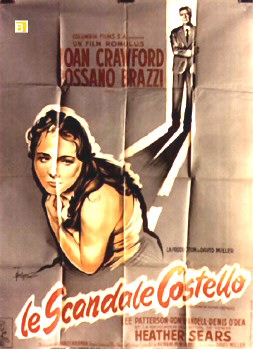
Above: Belgium, and two from France. Below: Italy.


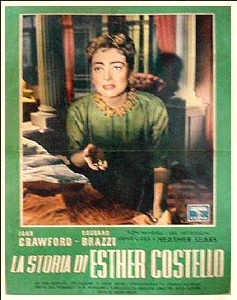

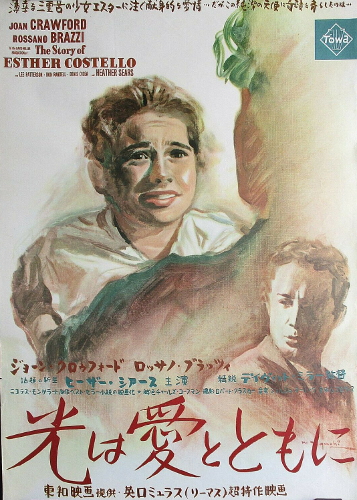

Above: Two from Japan, and one from Spain. Below: Sweden and two from UK.


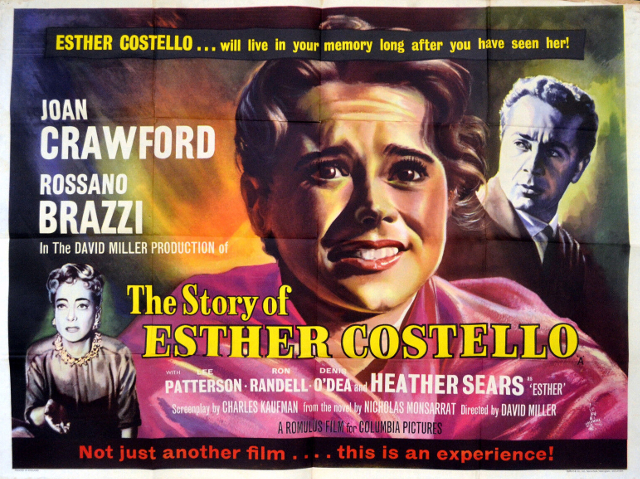
Below: US
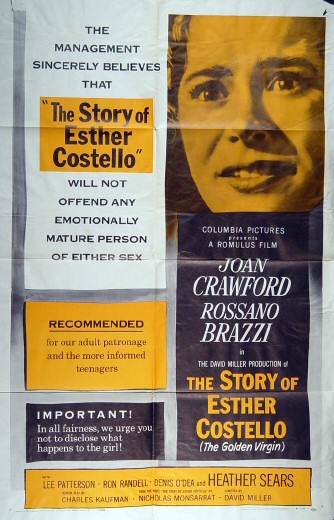
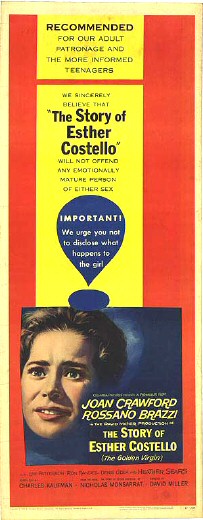
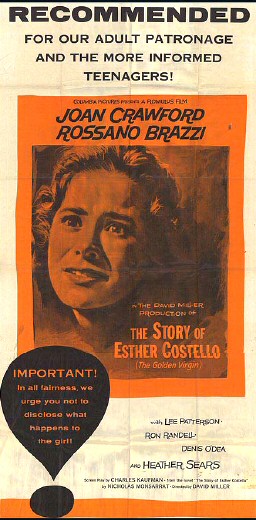
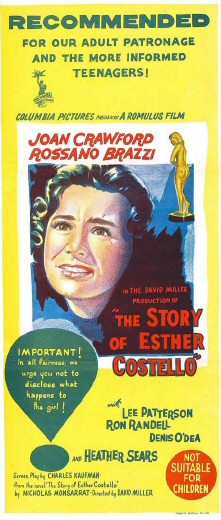

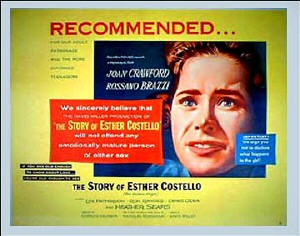
Below: Country unknown.









Above: US lobby cards. Below: Italian lobby, and Mexican lobby.
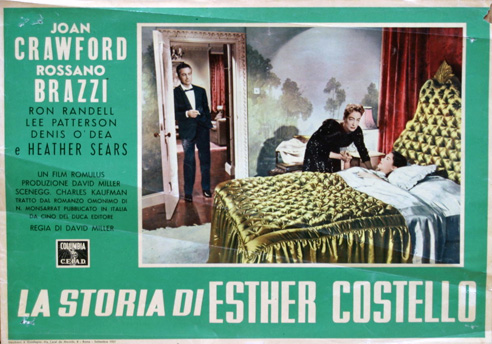
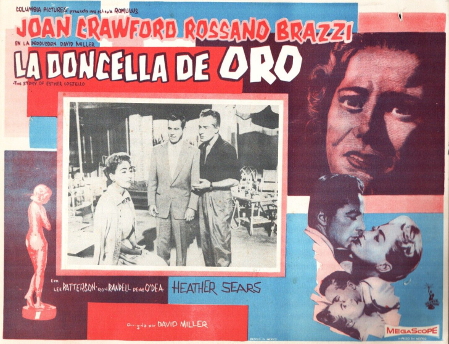


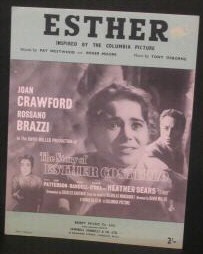
Above: Danish program, and UK sheet music. Below: Newspaper ads from Fort Smith, Arkansas.

See the Books Related to Joan Movies page for more info.
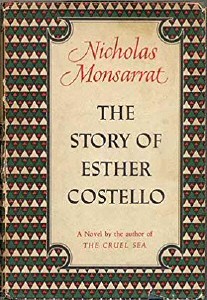

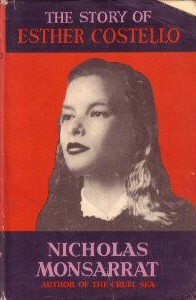
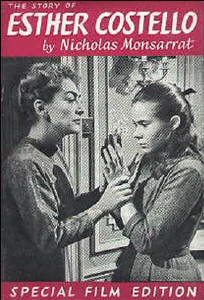
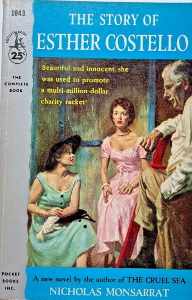
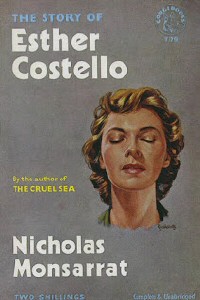
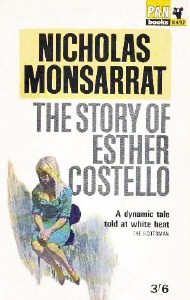
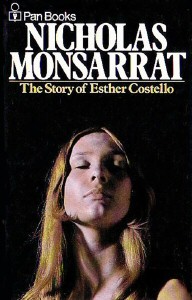
The Best of Everything